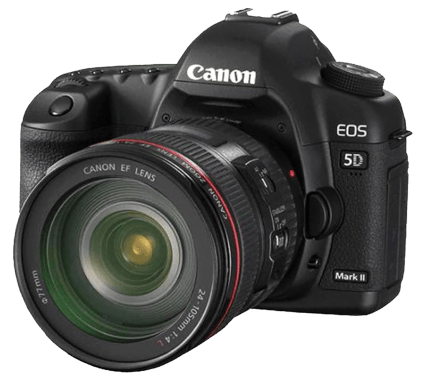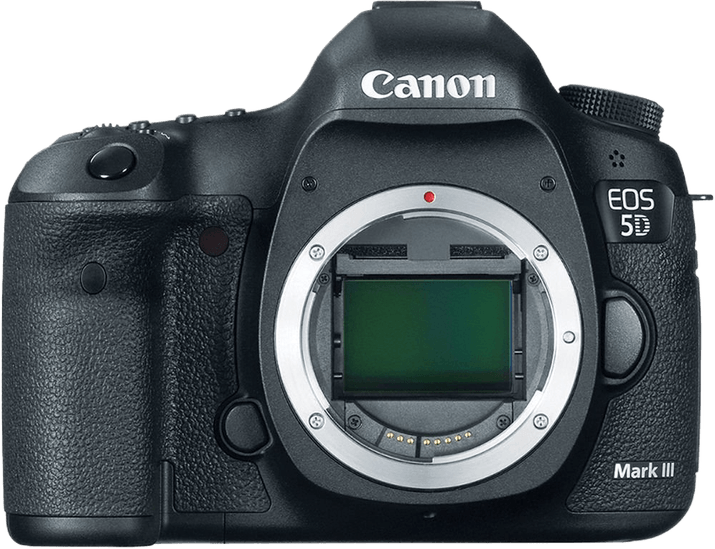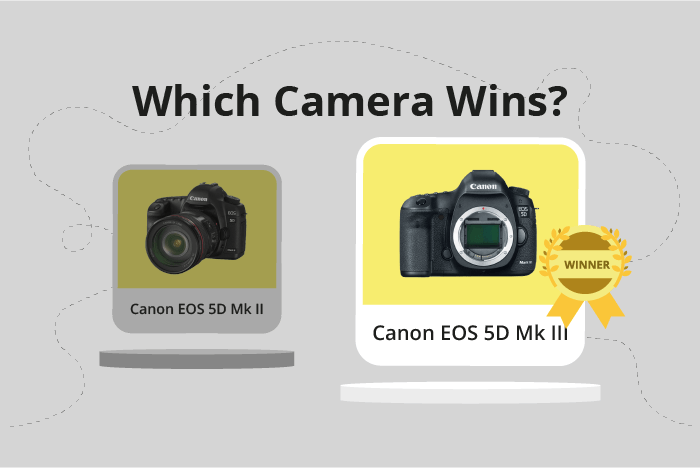Canon EOS 5D Mark II vs EOS 5D Mark III Comparison
Canon EOS 5D Mark II

Canon EOS 5D Mark III

The Canon EOS 5D Mark III comes out on top with a score of 65/100, while the Canon EOS 5D Mark II trails behind with a score of 58/100. Both cameras are DSLR models, announced in 2012 and 2008 respectively. They share similar dimensions, with the Mark III being slightly heavier at 950g compared to the 850g Mark II.
The Mark III’s higher score reflects its superior performance and features compared to the Mark II. Launched at a higher price of $3499, the Mark III offers improved specifications and capabilities, justifying the extra cost.
However, the Mark II still holds its own with a lower launch price of $2199, making it a more budget-friendly option for those not requiring the advanced features of the Mark III.
Ultimately, the Canon EOS 5D Mark III outshines the Mark II in terms of performance and features, making it the better camera of the two. Nevertheless, the Canon EOS 5D Mark II remains a viable option for those seeking a more affordable DSLR camera.
Canon EOS 5D Mark II vs EOS 5D Mark III Overview and Optics
The Canon EOS 5D Mark III emerges as the winner in the optics comparison with a score of 67/100, while the Canon EOS 5D Mark II scores 59/100. Both cameras share several specifications, including a CMOS sensor, Full Frame sensor size, Canon EF lens mount, and lack of image stabilization.
The 5D Mark III holds an advantage in several aspects. It possesses a higher megapixel count of 22.3 compared to the 5D Mark II’s 21 megapixels, which results in slightly better image resolution. The Mark III also boasts a faster shooting speed of 6 frames per second (fps) compared to the 3.9 fps of the Mark II, providing an improved ability to capture fast-moving subjects. Additionally, the Mark III features a more advanced Digic 5+ processor, which contributes to better overall image quality and processing speed. The DXOMARK score for the sensor is also higher in the Mark III at 81, as opposed to the Mark II’s score of 79, indicating a better sensor performance.
On the other hand, the 5D Mark II does not necessarily outperform the Mark III in any specific optical aspect. However, considering its lower score and older release date, it may be available at a more affordable price point, making it a viable option for budget-conscious photographers.
Taking these factors into account, the Canon EOS 5D Mark III proves to be a superior camera in terms of optics performance, with improvements in megapixels, shooting speed, processor, and sensor quality. While the 5D Mark II may offer a more budget-friendly alternative, those seeking enhanced optical capabilities should opt for the 5D Mark III.
Canon EOS 5D Mark II vs EOS 5D Mark III Video Performance
The Canon EOS 5D Mark III outperforms the Canon EOS 5D Mark II in video capabilities, scoring 56/100 compared to the Mark II’s 43/100. Both cameras share some video specifications, including Full HD max video resolution and 1920 x 1080 max video dimensions. Neither camera has built-in time-lapse functionality.
The Canon EOS 5D Mark III’s higher score is due to its superior max video frame rate of 60fps, compared to the Mark II’s 30fps. This allows the Mark III to capture smoother and more detailed video, especially in fast-moving scenes or when recording action. The doubled frame rate provides greater flexibility in post-production, enabling better slow-motion effects and more precise editing.
The Canon EOS 5D Mark II does not offer any significant advantages over the Mark III in terms of video capabilities. Its lower frame rate of 30fps is a clear disadvantage when capturing fast-paced action, and it lacks any features that would make it preferable for video recording.
To conclude, the Canon EOS 5D Mark III is the superior choice for video recording due to its higher frame rate of 60fps, which allows for smoother video and greater editing possibilities. The Canon EOS 5D Mark II does not offer any advantages in this area, making it a less suitable choice for those prioritizing video capabilities.
Canon EOS 5D Mark II vs EOS 5D Mark III Features and Benefits
The Canon EOS 5D Mark III emerges as the winner in the feature comparison, with a score of 59/100, while the Canon EOS 5D Mark II scores 54/100. Both cameras share some common specifications, such as the absence of a touchscreen, flip screen, GPS, and Bluetooth.
The 5D Mark III has a larger screen size of 3.2 inches compared to the 5D Mark II’s 3 inches. This provides a better, larger view for composing and reviewing images. Additionally, the 5D Mark III boasts a higher screen resolution of 1,040,000 dots, which results in a sharper and clearer display than the 5D Mark II’s 920,000 dots.
However, the 5D Mark II has a notable advantage in one aspect: it features built-in Wi-Fi connectivity, which the 5D Mark III lacks. This allows for easy sharing of images and remote camera control through compatible devices.
To summarize, the Canon EOS 5D Mark III outperforms the 5D Mark II in terms of screen size and resolution, making it the better choice for photographers who prioritize image composition and review. On the other hand, the 5D Mark II’s Wi-Fi connectivity offers a valuable feature for those who value easy image sharing and remote control capabilities.
Canon EOS 5D Mark II vs EOS 5D Mark III Storage and Battery
The Canon EOS 5D Mark III wins in storage and battery with a score of 76/100, compared to the Canon EOS 5D Mark II’s score of 71/100. Both cameras have two memory card slots and use the same LP-E6 battery type. Neither camera offers USB charging capabilities.
The 5D Mark III outperforms the 5D Mark II by accepting more memory card types, including SD, SDHC, and SDXC, in addition to Compact Flash and UDMA. This flexibility allows for a wider range of storage options for photographers. Furthermore, the 5D Mark III has a longer battery life, providing 950 shots, whereas the 5D Mark II lasts for 850 shots.
The 5D Mark II does not have any advantages over the 5D Mark III in terms of storage and battery. Thus, the 5D Mark III is the superior choice for photographers seeking better storage options and battery life.
Alternatives to the Canon EOS 5D Mark II and EOS 5D Mark III
Are you still undecided about which camera is right for you? Have a look at these popular comparisons that feature the Canon EOS 5D Mark II or the Canon EOS 5D Mark III:

